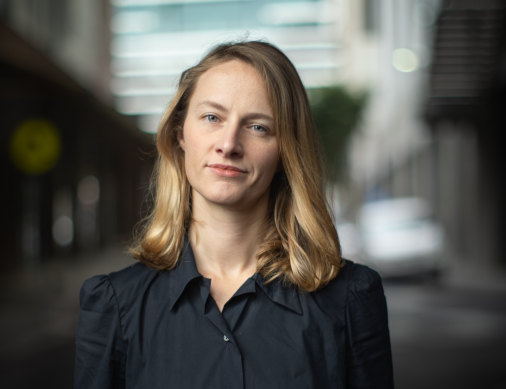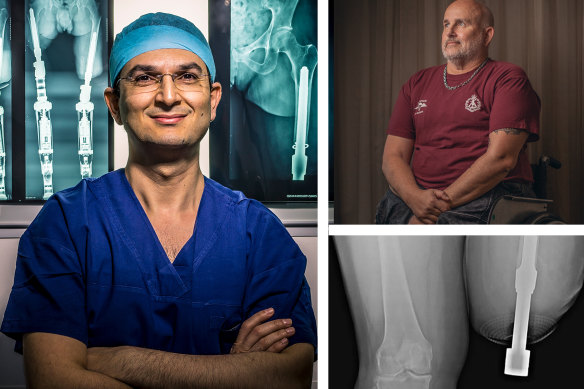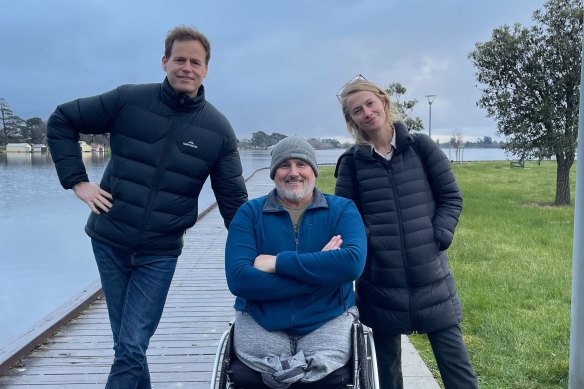This was published 2 years ago
Behind the scenes: exposing the downside of a celebrity surgeon’s practice
There are plenty of places that news stories come from. A tip-off, a source, a leak. But sometimes, a story simply comes from conversations with people you know.
In this case, the investigation into surgeon Munjed Al Muderis came from a conversation with my father.

Over three months investigative reporter Charlotte Grieve spoke to patients, medical staff and whistleblowers to piece together her To the Bone investigation.Credit: Simon Schluter
He is an amputee who had a consultation with Al Muderis years ago and was told if he did not immediately have osseointegration surgery, he would soon be in a wheelchair.
After getting a second opinion, he decided against the surgery and today, he’s still walking.
But Al Muderis’ pressure, combined with warnings from other health professionals, stuck with me, so when I joined The Age’s investigations team in June on a six-month secondment, I decided to have a closer look.
I quickly discovered concerns around Al Muderis’ practice were somewhat of an open secret among orthopaedic surgeons — particularly his approach to patient selection and aftercare.
“Everyone has a story about Munjed Al Muderis,” one Sydney surgeon told me.
Over the next three months, I spoke to patients, medical staff and whistleblowers in back-to-back phone calls. Through translators, I tracked down patients in Iraq and Cambodia. Late at night, I phoned sources in Europe, the US, Canada and UK.
My notes document ballooned to hundreds of pages, becoming so large it froze each time I opened it. I collected thousands of internal documents — emails, texts, reports — that together painted a clear picture of a business determined to grow at all costs.
But initially, no one wanted to go on the record. Al Muderis had successfully sued one of his former patients for defamation, and many were worried he would do the same to them if they spoke out.
Military veteran Mark Urquhart was one of the first patients I met in person. I arrived at his hotel room in Melbourne on a bleak winter’s night, where he was staying with his daughter as he travelled from Bundaberg to Tasmania to start a new life.

Munjed Al Muderis made his name in a procedure called osseointegration. For some it’s been an unhappy experience.Credit: Composite
He had put the anger of what had happened behind him, and calmly showed me photos of the surgery, and what followed. We spoke for hours and that night, he made the commitment to go public.
Patients knew there was power in numbers and when enough agreed to speak publicly, I pitched the idea for an accompanying TV story with 60 Minutes. Over time, former nurse turned whistleblower Shona and surgeon John Anstee also agreed to go on the record. The story was coming together.
With 60 Minutes, we travelled to Ballarat, Sydney, Brisbane and Melbourne for interviews. Sitting in front of a camera is daunting, but award-winning reporter Tom Steinfort was excellent in putting people at ease. Producer Natalie Clancy’s organisational skills whipped everyone into shape. Talented camera operators, sound recordists, photographers and graphic designers brought the series to life.
The end result was a feature-length documentary, and multimedia news stories published in The Age and Herald, which uncovered the downside of Al Muderis’ practice for the first time.
When the stories were published, my inbox was quickly flooded with emails detailing fresh allegations about the surgeon’s work.
There was also fierce pushback from his “cult” following, who viewed the program as an attack rather than an opportunity for improvement. A petition was launched in his favour which attracted 1500 signatures. I was saddened to see some of his supporters insult patients we interviewed online, and worse, the surgeon himself make a joke at a patient’s expense last week.
Al Muderis’ medical insurer quickly suspended his cover and launched an investigation. While he is back operating again, regulators are now assessing new complaints from patients.
Al Muderis enjoyed more than a decade of dazzling media coverage which played a key role in sending patients his way. This story is perhaps a lesson for journalists, and doctors, about the danger of mixing health with fame. It also exposes the weaknesses of Australia’s health regulators, which failed to act on complaints.
Unfortunately, there is no happy ending. Today, many patients still deal with the horrific new realities. Carol Todd, for example, has to amputate what’s left of her leg or doctors say the 71-year-old may die. Veteran Brennan Smith has been told he needs further surgery to treat the chronic infection in his bone.

Grieve (right) in Ballarat with 60 Minutes Tom Steinfort (left) to interview military veteran Mark Urquhart, one of Al Muderis’ former patients.
This has not been an easy story to tell. Al Muderis has threatened to sue Nine for defamation. So thank you to our subscribers, editors and lawyers for getting it across the line in the pursuit of public interest journalism.
The Age’s investigation team is made up of the country’s most talented journalists, whose work has triggered royal commissions and changed laws. It’s the epitome of why journalists enter the industry – to have impact.
So when the team was hiring last year, I jumped at the opportunity and was thrilled to be offered this six-month secondment, stepping away from my role as a business reporter.
I studied a Master of Journalism at the University of Melbourne, where Richard Baker taught its investigative journalism class. It’s hard to believe that only a few years later I would be working alongside him.
To be given six months to apply myself to in-depth projects was also a dream come true.
It’s been one of the most challenging, and rewarding, experiences of my career. And now, Baker’s decision to leave The Age has meant a permanent spot has become available in the team. He has left enormous shoes to fill, but I can’t wait to see where this journey takes me next.